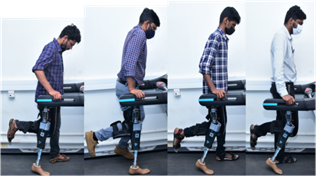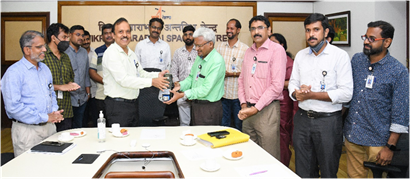Introduction
As a spin-off of space technology, VSSC had developed an intelligent MicroProcessor controlled Knee (MPK) for above knee amputee. The MPK offers extended capabilities for the amputees than those offered by passive knee joints. These smart MPKs are being developed by Vikram Sarabhai Space Centre (VSSC), under an MoU with National Institute for Locomotor disabilities (NILD), Pt. Deendayal Upadhyaya National Institute for Persons with Physical Disabilities (Divyangjan) (PDUNIPPD (D)), and Artificial Limb Manufacturing Corporation of India (ALIMCO).
Configuration and working
An MPK consists of a microprocessor, hydraulic damper, load & knee angle sensors, composite knee case, Li-ion battery, electrical harness and interface elements. The microprocessor detects the state of gait based on the senor data. The control software estimates the real time damping needed to attain desired gait by changing the stiffness of the system that is achieved by a hydraulic damper operated by a DC motor. Walking parameters specific to amputee can be set using PC-based software to improve one’s comfort. The interface plots the parameters real time during walking.
Development of the system
 The development of MPK was a multi-disciplinary multi-stage activity. After arriving at a configuration through literature, validating it through kinematic analysis for estimating sub-system requirements, multiple models of the system were developed. The feasibility of design was verified using an engineering model. The system consisted of an aluminium knee case, a solenoid valve-based damper, and six-axis load cell. While the next engineering model included a stepper motor-based damper and composite knee case, the subsequent model utilised a DC motor based damper with a spool position sensor, pylon integrated load cell, miniaturised control electronics, and a Graphical user interface for parameter tuning.
The development of MPK was a multi-disciplinary multi-stage activity. After arriving at a configuration through literature, validating it through kinematic analysis for estimating sub-system requirements, multiple models of the system were developed. The feasibility of design was verified using an engineering model. The system consisted of an aluminium knee case, a solenoid valve-based damper, and six-axis load cell. While the next engineering model included a stepper motor-based damper and composite knee case, the subsequent model utilised a DC motor based damper with a spool position sensor, pylon integrated load cell, miniaturised control electronics, and a Graphical user interface for parameter tuning.
Testing and trials at VSSC
The sub systems of the limb, viz. hydraulic damper, control electronics, and load cell, were independently tested and characterised in stand-alone mode, using customised setups. An ingenious method was conceived of conducting walking trials with non-amputee involving a custom designed exo-socket realised for the purpose. Multiple walking trials conducted with non-amputee enabled the updating of the control software and fine tuning of the parameters.

Walking trials with amputee
With the clearance of the Joint Project Monitoring Committee (JPMC), the device was handed over to NILD by Director, VSSC and trials were conducted at NILD lab jointly by NILD and VSSC.


Identification of amputee and realisation & fitment of socket to amputee were carried out by NILD. Tuning of amputee specific parameters during trials was conducted by VSSC. Initial walking trials were conducted with the support of parallel bars. Subsequently, the amputee could walk about 100 m in the corridor with minimum support. All the sub-systems of the knee performed satisfactorily.
Further plans
MPKs currently available commercially in India are imported and range from Rs. 10 Lakh to Rs. 60 Lakhs, depending on the complexity and functionality. MPKs being developed, once commercialised, are expected to cost around Rs. 4 Lakhs to Rs. 5 Lakhs. Optimisation of MPKs in terms of mass and envelop size is underway. More intelligence is being incorporated into the system to help the amputee walk through uneven terrains with advanced features for more comfort.